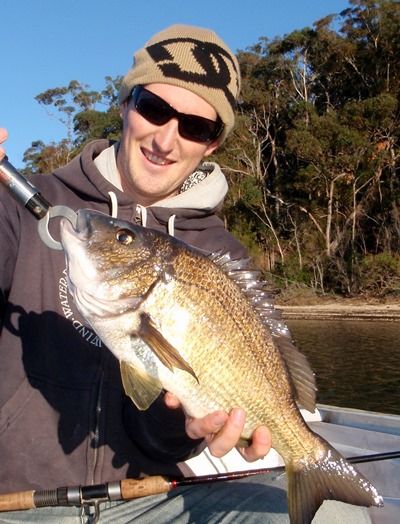Latest News
Fishing Report - Master South Coast Bream on plastics and the rest is easy…by Graham Fifield
Wednesday, 5 February 2014
There's a saying that if you can catch bream on soft plastics, you can catch anything that swims.
This is because bream can be difficult to catch on lures and require a good grounding in all the basic skills for weekend anglers. The big old fish also have a reputation for cunning and make a fine adversary for experienced competition anglers. Whether your motivation is to catch your first big bream, or to claim top honours at an upcoming competition, with these five tips you'll be well on your way.
Bream love hiding near hard structures, especially fallen trees, oyster leases, moored boats, bridge pylons and rock walls. They don’t like to stray far from home to chase a lure though, so tip 1 is to cast accurately. The best bream anglers regularly land their lure less than two metres from the structure.
Bream are timid and will often sit in the shadows just underneath a submerged log or moored boat, or beside a vertical rock wall or bridge pylon. So tip 2 is to pick the correct weight of jig head for the conditions. If the head is too heavy, the lure will sink straight past the fish’s nose. Too light and the fish might be looking up at your lure in bewilderment. As a rule, stray on the lighter side and allow time for the lure to sink slowly in a more natural fashion. One to two grams (1/16 – 1/24 oz) is a good starting point, but be willing to go heavier or lighter as conditions dictate. Have two or three different weights prepared - experimenting is half the fun. Bream have small mouths so keep the hook size down to #1 or #2.
Tip 3 is to use a soft plastic that is the right size and shape. The most popular plastics for bream are curly-tailed grubs, 2-3 inches long, in transparent pink, red, silver or brown. Once you’ve settled on a jig head and plastic combination, the next challenge is the retrieve. Tip 4 is to perfect the 'twitch-pause retrieve' that is synonymous with bream fishing. It keeps the lure near to the structure and is vital to attract a bite. Cast into a likely spot and let the lure sink. Twitch the rod tip upwards just a few inches and let the lure slowly sink again. Maintain contact with the lure by winding in the slack as you drop the rod tip. Keeping the line taut is important because a bream will usually suck in the lure as it is sinking and you will need to react quickly before it spits it out. If you’re in doubt how long to wait between twitches, let the lure sink to the bottom each time.
Tip 5 is to ensure you’ve got the right gear. Experienced tournament anglers are adamant that bream bite less often on heavy fishing lines. Too light however, and you risk snapping the line while trying to keep the fish away from rocks or timber. Six pound line - either as monofilament main line or as a rod length of leader - is a good place to start. If the fish are shy, try downsizing to 4lb. Non-stretch braided main lines in the 4-6lb class are popular, matched with 1000-2500 sized reels and 1-4kg rods. Light set ups are required to accurately cast these small lures.
Tuross bream and flathead competition, March 8 & 9
Once you’re comfortable with these techniques, why not test your skills against other anglers for the ultimate bragging rights in the annual Tuross bream and flathead competition? This catch-and-release tournament has $5,000 worth of prizes and the chance to win $50,000. Prizes will be given for the longest bream, the longest flathead, and the longest total length for two of each species. Entry forms and further details can be found at www.turossheadfishingclub.org
At first you might find it hard to catch bream on soft plastics but stick with it. The first fish will be supremely satisfying and as you learn how to fish different structures by perfecting your casting accuracy, jig head, plastic and line choice, you'll become a much better angler. You might even take home a trophy!
Graham Fifield



